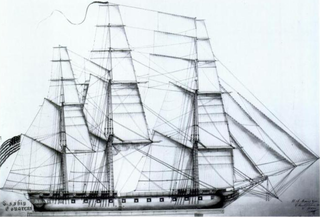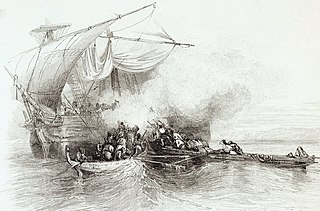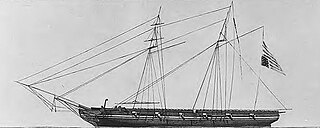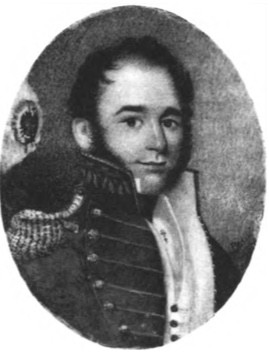
David Glasgow Farragut was a flag officer of the United States Navy during the American Civil War. He was the first rear admiral, vice admiral, and admiral in the United States Navy. He is remembered for his order at the Battle of Mobile Bay, usually paraphrased as "Damn the torpedoes, full speed ahead" in U.S. Navy tradition.

David Porter was an officer in the United States Navy in the rank of captain and the honorary title of commodore. Porter commanded a number of U.S. naval ships. He saw service in the First Barbary War, the War of 1812 and in the West Indies. On July 2, 1812, Porter hoisted the banner "Free trade and sailors' rights" as captain of USS Essex. The phrase resonated with many Americans. Porter was later court martialed; he resigned and then joined and became commander-in-chief of the Mexican Navy. Porter County, Indiana was named after him.

Commodore Josiah Tattnall was an officer in the United States Navy during the War of 1812, the Second Barbary War and the Mexican–American War. He later served in the Confederate Navy during the American Civil War.
Sea Gull was a steamship in the United States Navy. She was the second steamship of the United States Navy and the first to serve actively as a warship.

The first USS Shark was a schooner in the United States Navy. Built in the Washington Navy Yard to the designs of Henry Steers, Shark was launched on 17 May 1821. On 11 May 1821, Matthew C. Perry was ordered to take command of Shark, and the ship was ready to receive her crew on 2 June 1821.
Commodore John Thomas Newton was an officer in the United States Navy who commanded several ships over a period of decades, undertaking missions in the Caribbean and leading the first crossing of the Atlantic by an American steam-powered warship. He was court-martialed following a fire that destroyed that vessel, but his suspension from service was remitted by President John Tyler, after which Newton commanded Pensacola Navy Yard and the Home Squadron for periods. He died while serving in his last post as president of a Naval Court of Inquiry.

The term Mosquito Fleet has had a variety of naval and commercial uses around the world.
Diabolito or Little Devil was a 19th-century Cuban pirate. One of the more violent of the era, he engaged the United States Navy and Revenue Marine Service several times, being one of the main fugitives hunted and pursued later by American Naval forces during the West Indies anti-piracy operations of the United States in the Caribbean during the 1820s. He was also known for having a mixed-race crew, which included “English, Frenchmen, Spaniards, Mulattoes, and Negroes.”
USS Decoy was a schooner in the United States Navy during the 1820s. Decoy was purchased 27 December 1822 by Commodore David Porter in New York under the name Zodiac.
USS Beagle was a schooner in the United States Navy during the 1820s. Beagle was purchased by the Navy on 20 December 1822 in Baltimore, Maryland, and commissioned early in 1823, Lieutenant John T. Newton in command.

The action of 9 November 1822 was a naval battle fought between the United States Navy schooner USS Alligator and a squadron of three pirate schooners off the coast of Cuba during the Navy's West Indies anti-piracy operation. Fifteen leagues from Matanzas, Cuba, a large band of pirates captured several vessels and held them for ransom. Upon hearing of the pirate attacks, Alligator under Lieutenant William Howard Allen rushed to the scene to rescue the vessels and seize the pirates.

The West Indies Squadron, or the West Indies Station, was a United States Navy squadron that operated in the West Indies in the early nineteenth century. It was formed due to the need to suppress piracy in the Caribbean Sea, the Antilles and the Gulf of Mexico region of the Atlantic Ocean. This unit later engaged in the Second Seminole War until being combined with the Home Squadron in 1842. From 1822 to 1826 the squadron was based out of Saint Thomas Island until the Pensacola Naval Yard was constructed.

Aegean Sea anti-piracy operations began in 1825 when the United States government dispatched a squadron of ships to suppress Greek piracy in the Aegean Sea. The Greek civil wars of 1824–1825 and the decline of the Hellenic Navy made the Aegean quickly become a haven for pirates who sometimes doubled as privateers.
The first USS Terrier was a United States Navy schooner in commission from 1823 to 1825. It was part of the West Indies squadron and served transporting U.S. sailors, marines and supplies to the pirate infested waters of the Caribbean and was used to search out and attack pirate ships and pirate strongholds.

The West Indies Anti-Piracy Operations were a series of military operations and engagements undertaken by the United States Navy against pirates in and around the Antilles. Between 1814 and 1825, the American West Indies Squadron hunted pirates on both sea and land, primarily around Cuba and Puerto Rico. After the capture of Roberto Cofresi in 1825, acts of piracy became rare, and the operation was considered a success, although limited occurrences went on until slightly after the start of the 20th century.

Commodore John R. Goldsborough was an officer in the United States Navy. Goldsborough was made a cadet-midshipman in 1824 and as such saw action in the Mediterranean against pirates. In one incident, while in charge of 18 men he attacked and captured a Greek pirate ship with a 58-man crew.
USS Ferret was a two masted schooner, the third U.S. Navy vessel to bear this name, and was purchased 20 December 1822 at Baltimore, Maryland and commissioned early in 1823, with Lieutenant R. Henley in command. It was the first U.S. naval ship commanded by the famous naval hero David Farragut. Ferret served transporting U.S. sailors, marines and supplies to the pirate infested waters of the Caribbean and was used to search out and attack pirate ships and pirate strongholds for a little more than two years when her career was cut short when the vessel capsized in a gale force storm off the coast of Cuba.

USS Wildcat was a two masted schooner of 48 tons and was part of a U.S. naval fleet, and part of the West Indies Squadron, that sailed to the Caribbean to subdue the occurrence of pirate raids on merchant ships that had increased to almost 3,000 by the early 1820s. She was armed with three guns and had a crew of 31. Wildcat was commanded by Lieutenant Legare' who sailed her to Washington with a dispatch regarding the disposition of the squadron and other matters concerning the war against piracy in the Caribbean. On 28 October 1824 Wildcat was lost in a gale with all hands while sailing between Cuba and Thompson's Island, West Indies. Approximately 31 drowned.
The USS Weasel was a three-gun schooner in the United States Navy.

Thomas Jefferson Leib was an American naval officer of the early 19th-century sailing ship era, active in Florida's Second Seminole War as well as anti-piracy and smuggling suppression patrols throughout the Gulf of Mexico, Caribbean Sea, and West Indies.











